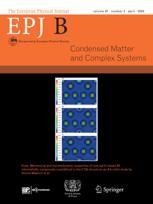Studying the pseudogap in superconducting cuprate materials
Despite being vital to the study of superconductivity in cuprate materials the physical origins of the pseudogap remain a mystery.
New York | Heidelberg, 6 May 2022
 Over three decades since the discovery of high-temperature superconductivity in ceramic cuprate materials, investigating the electronic states in cuprate materials to advance the understanding of the superconducting phase and related phenomena has become of incredible importance.
Over three decades since the discovery of high-temperature superconductivity in ceramic cuprate materials, investigating the electronic states in cuprate materials to advance the understanding of the superconducting phase and related phenomena has become of incredible importance.
In a new paper published in the EPJ B, Ernesto Raposo from the Federal University of Pernambuco, Brazil, and his co-authors, look at one of the essential physical properties of cuprate superconducting compounds, the pseudogap, which describes a state where the Fermi surface of a material possesses a partial energy gap.
Despite impressive progress in the study of cuprate superconducting compounds, the authors point out that researchers have yet to reach a consensus on the physical origin of the pseudogap phase in these compounds.
To tackle this problem, the team employs the one-band Hubbard Hamiltonian of interacting neighbouring electrons on the CuO2-planes of cuprate systems to examine the emergence of the pseudogap phase.
As well as considering the usual on-site Coulomb repulsion energy and hopping of electrons to the nearest neighbour sites, the researchers also considered a competing mechanism of jumps to next-nearest neighbour sites.
To conduct their study, the team doped the system either with electrons or holes to approximate the critical doping concentrations at which the pseudogap closes down in addition to estimating the concentration range over which it is sustained.
Using a model created to reflect the parameters of the cuprate compound La2CuO4, the team found the critical electron and hole doping concentrations and also obtained the charge-transfer gap and maximum pseudogap energies.
The authors say that the pseudogap does not open when the next-nearest-neighbouring kinetic energy nullifies, describing this finding as remarkable.
The researchers’ calculations indicate that the hopping energy to the next-nearest neighbour matches the value of the observed pseudogap in the experimental measure in cuprate systems.
This suggests that competing electron hopping along the nodal directions of the sublattice Brillouin zone could play a role in the emergence of the pseudogap phase in cuprate materials.
Reference: Vielza, Y., de Oca, A.C.M., Coutinho-Filho, M.D. et al. Pseudogap Mott-phase in cuprate superconductors: a Hartree–Fock study with limited next-nearest-neighbor hopping, Eur. Phys. J. B 95:33, https://doi.org/10.1140/epjb/s10051-022-00298-w
Further Information
For more information visit: www.epj.org
Services for Journalists
The full-text article is available here.
Contact
Sabine Lehr | Springer | Physics Editorial Department
tel +49-6221-487-8336 | sabine.lehr@springer.com
